With chewy glass noodles, a sweet and savory sauce and colorful vegetables, Japchae is the perfect meal to serve to noodle lovers. Master this Korean street-food classic in your own kitchen. It’s ready in about 25 minutes from start to finish!

Table of contents
Why This Recipe Works
- Slippery glass noodles and veggies in an addictive umami, nutty and sweet sauce.
- As tasty as a late night snack as it was for dinner.
- Quick and easy. Minimal cooking, authentic street food flavor.
- A great way to eat your veggies without it feeling like a chore.
What is Japchae
Japchae (잡채 – or chapchae) is a popular Korean noodle stir fry made with sweet potato noodles, vegetables, and sometimes meat. The dish is seasoned with a mixture of soy sauce, sugar, and sesame oil. While japchae is super popular during holiday celebrations, at its core it is a Korean staple dish – served any day of the week.
Is Japchae Vegan?
This one is! While many Korean glass noodle recipes include seasoned meat, the word japchae actually translates directly as mixed vegetables. I’m only using veggies for my recipe, so 100% vegan. But feel free to tweak it by adding your favorite protein if you prefer it that way.
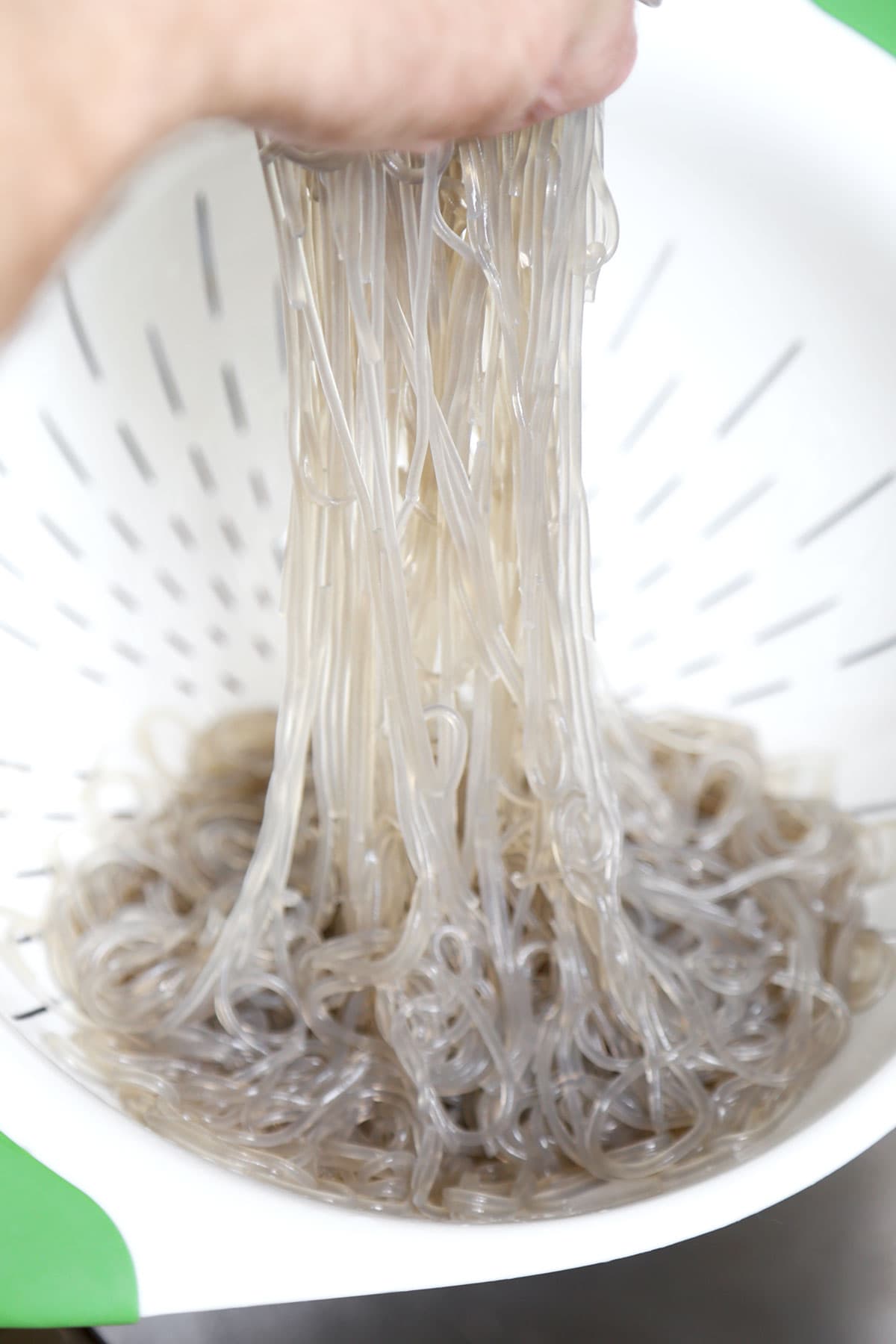
What are Sweet Potato Noodles (Dangmyeon)
Sweet potato noodles are made from the starch of sweet potatoes. You’ll also hear them called cellophane noodles or glass noodles (dangmyeon – 당면 – in Korean).
Uncooked, they are stiff and grayish. However, they become translucent after being boiled. Dangmyeon will usually turn clear after boiling for about 4-5 minutes or so. Since cooking times vary by brand, it’s best to follow the instructions on the package.
Pro tip: Some brands of sweet potato starch noodles come pre-cut – and some are super long. You can cut long noodles in half or thirds with scissors, after cooking and cooling, to make sure your japchae is easier to eat!
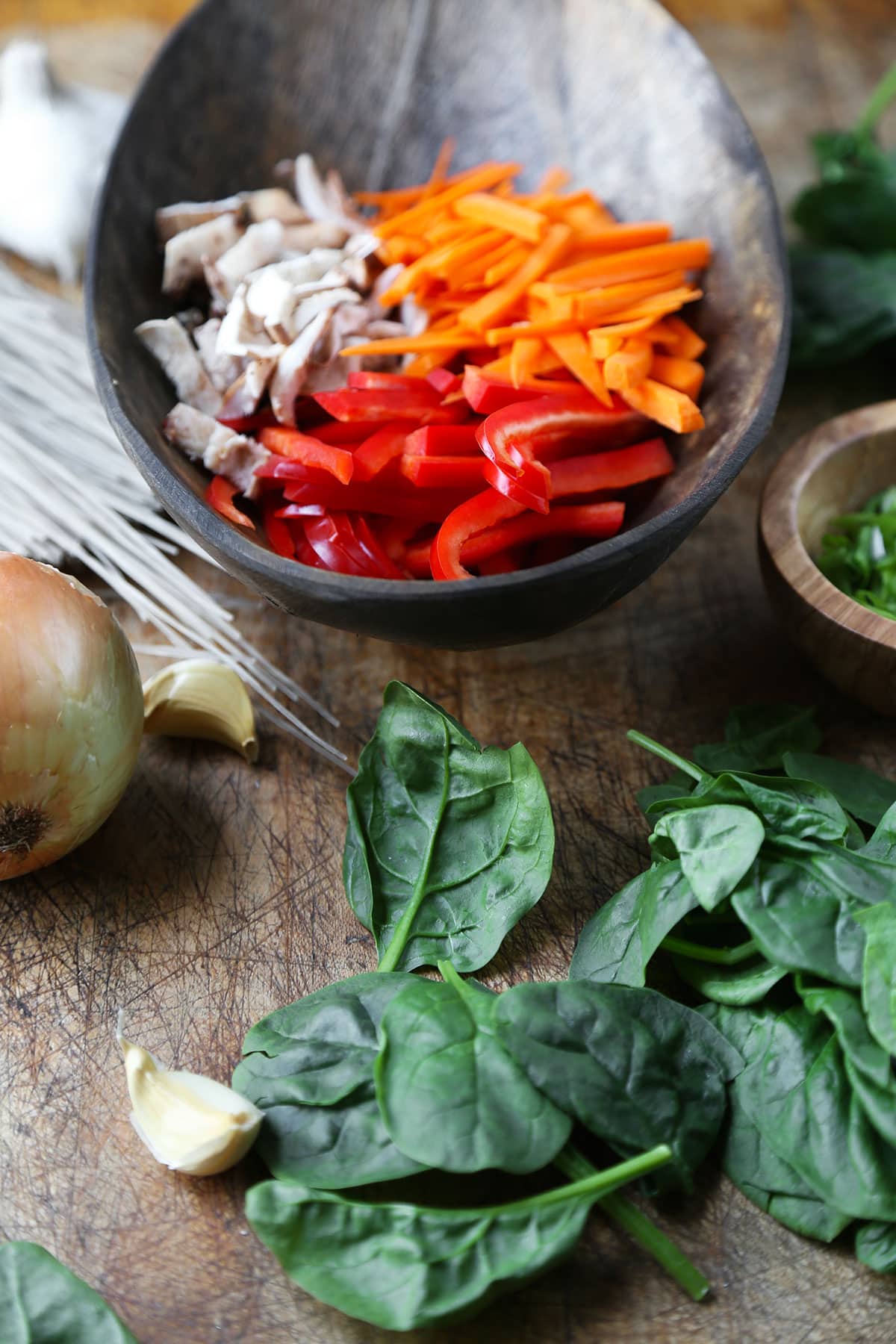
Ingredients for Japchae
Scroll to the bottom of this post for the full recipe!
- Sweet potato noodles: Chewy sweet potato noodles are imperative to the success of this dish. There are unfortunately no substitutes for them, but the good news is they are fairly easy to find in Asian grocery stores.
- Oil: Pick a neutral cooking oil such as vegetable, peanut or grapeseed oil.
- Garlic: For a little sweetness and pungency.
- Onion: Thinly sliced your onions into half-moons.
- Shiitake mushrooms: Shiitakes are tender and a little chewy. I find that the texture of shiitake mushrooms can almost mimic the texture of meat. But if you can’t find shiitakes, go ahead and use any other type of mushrooms, except for enoki.
- Bell pepper: Aesthetically, red bell peppers pop in japchae. But feel free to use green, yellow, orange bell peppers.
- Carrot: Carrots are great for texture and sweetness. The julienne cut is preferred for this recipe.
- Spinach: You can use regular or baby spinach. Half a pound might seem like a lot but since spinach wilts so much, it ends up being just the right amount.
- Scallions: Crunchy and bright!
- Sesame seeds: For added nuttiness and presentation.
- Japchae sauce: A mixture of dark soy sauce, regular soy sauce, sugar, and sesame oil.
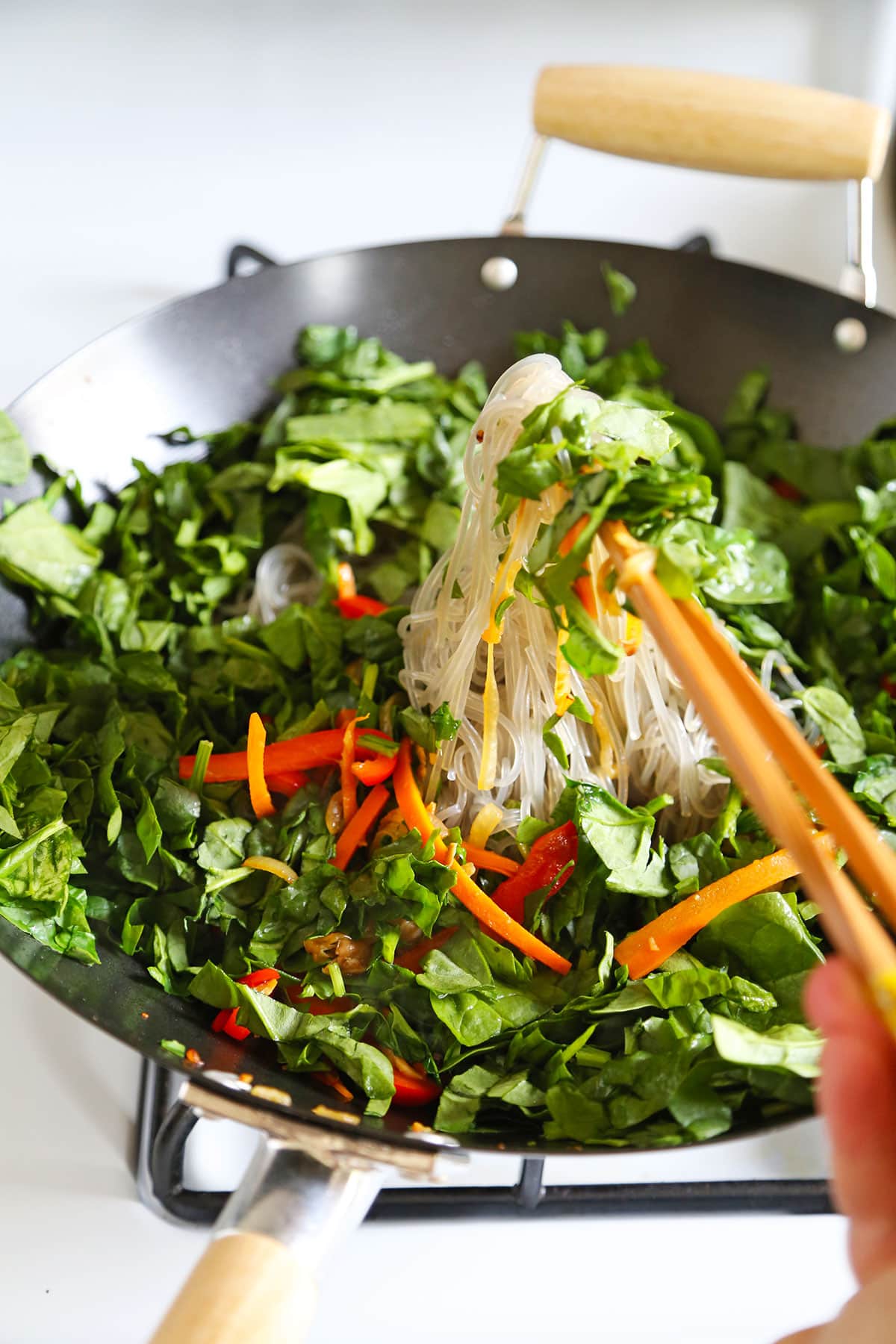
How to Make Japchae
- Chop the vegetables and set them aside.
- Then fill a large pot with water and bring it to boil. Add the noodles and cook them according the directions on the package. If the directions are in Korean and you can’t read them, 4-5 minutes is usually the norm for boiling sweet potato noodles. Test often.
- Drain the noodles and rinse under cold water. Drain them again and transfer to a bowl. If you are using long noodles, grab scissors and cut the length in half or thirds. Add the sesame oil and toss the noodles (this is to prevent them from sticking together).
- Next, mix the ingredients for the japchae sauce in a bowl and set aside.
- Get the garlic and onion going in a wok over medium high heat, with a little oil. Once the onions are translucent, add the carrot, bell pepper, and shiitake mushrooms. Cook for 3-4 minutes until the vegetables are tender but still a little crunchy.
- Add the noodles and spinach and toss well.
- Stir in the sauce and toss well, until the noodles and vegetables are evenly coated.
- Finally, transfer the japchae to a plate and top with sesame seeds and scallions. Serve hot or at room temperature.
Pro tip The sesame oil pulls double duty in this recipe. It’s used for toasted, nutty flavors in the sauce. But you’ll add some sesame oil to the boiled and drained noodles to prevent them from sticking together in a clump while you’re working on the rest of the recipe steps.

Frequently Asked Questions
Not this time. Sorry. You know how much I love giving you options when it comes to swapping out one ingredient for something else? A lot! But there’s nothing quite like these slippery Korean sweet potato noodles. For reference, I tried making this recipe with rice vermicelli noodles once. It was yummy, but just not right. Luckily, dangmyeon are fairly easy to track down, both online, and at many Asian grocery stores these days.
The Korean glass noodles themselves are vegan. In fact, this entire japchae recipe is vegan. Now, uncooked glass noodles are gluten free. However, it’s important to note that this recipe is not gluten free as written. If you’re following a wheat-free diet you’ll need to swap out the soy sauce for something like tamari or liquid aminos.
This recipe calls for both regular and dark soy sauces. Dark soy sauce is sweeter and thicker than regular soy sauce. It’s also used as a food coloring to impart deep caramel hues to meat, noodles and stir fries. Read all about dark soy sauce here. However, it’s not an obligatory ingredient for this recipe. You can either skip it and just use regular soy sauce in its place – or pick some up here on Amazon.
Nope! Not at all. Any reasonably large frying pan or skillet will do.
How to Serve
No rules. Eat them fresh out of the wok, at room temperature, or even cold, and they are just as delicious. There’s no wrong way to eat japchae!
What to Eat With Japchae
Here are a few of my favorite dishes that pair well with these cellophane noodles:
- Vegan Kimchi
- Kimchi Tofu Mandu (Korean Dumplings)
- Vegetarian Kimbap
- Korean Steamed Egg (Gyeran Jjim)
- Korean Cucumber Salad
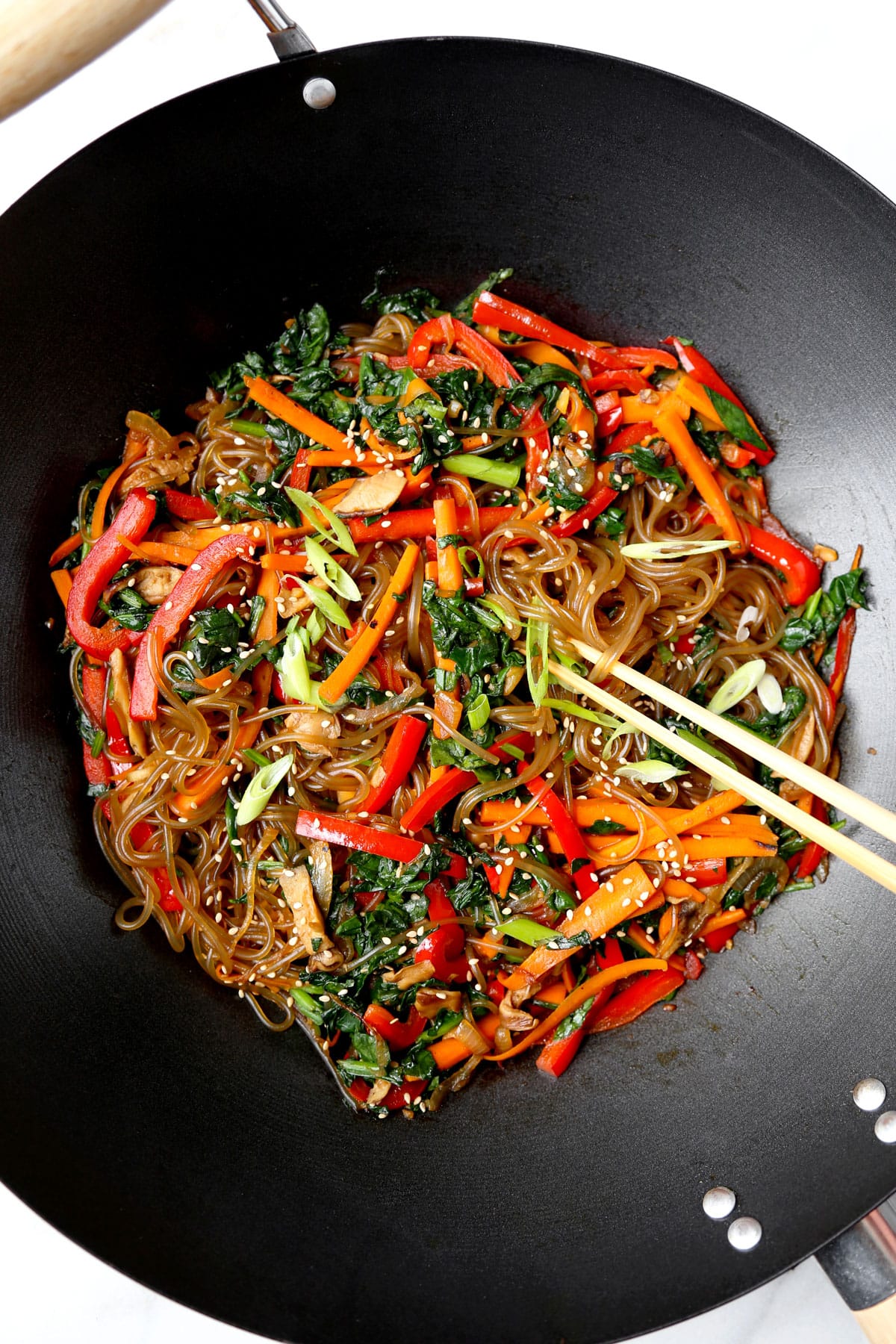
Storage
Store any leftover japchae in an airtight container in the refrigerator for 2-3 days.
- These leftovers taste great cold and at room temperature. But you can pop them in microwave if you prefer them hot.
- While you can technically freeze leftovers, I have never had good luck with that personally. I’ve found that frozen and thawed japchae has an unpleasant, mushy texture. Your own mileage may vary.
Subscribe to my newsletter and receive the latest recipes and weekly favorites straight to your inbox. Join me on Pinterest, Facebook, and Instagram for more cooking tips and adventures!
Did you like this japchae recipe? Are there changes you made that you would like to share? Share your tips and recommendations in the comments section below!
Print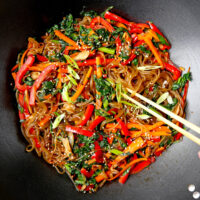
Japchae Recipe (Korean Glass Noodles)
- Prep Time: 15 minutes
- Cook Time: 12 minutes
- Total Time: 20 minutes
- Yield: 4 people 1x
- Category: Main
- Method: Stir frying
- Cuisine: Korean
- Diet: Vegan
Description
A savory, sweet and nutty Japchae Recipe that marries chewy Korean glass noodles with stir-fried veggies. Ready in about 25 minutes.
Ingredients
- 200 grams sweet potato noodles (dangmyeon), dry
- 2 teaspoons sesame oil
- 1 tablespoon neutral oil such as vegetable or grapeseed oil
- 2 cloves garlic, minced
- 1 medium onion, thinly sliced into half-moons
- 6 shiitake mushrooms, sliced into strips
- 1/2 red bell pepper, sliced into thin strips
- 1 medium carrot, sliced into thin strips
- 1/2 pound baby spinach, roughly chopped
- 3 stalks scallions, finely chopped on the bias
- 1 tablespoon sesame seeds
Japchae sauce
- 3 tablespoons soy sauce
- 1 tablespoon dark soy sauce
- 2 teaspoons sugar
- 1 tablespoon sesame oil
Instructions
- Bring a pot of water to boil and add noodles. Follow instructions on package for cooking time (usually about 5 minutes).
- Drain and rinse the noodles under cold water. Drain again and transfer them to a bowl. If the noodles are long, cut them in half or thirds with scissors.
- Drizzle sesame oil over the noodles and toss. Set aside.
- Put all the ingredients for the sauce in a bowl and stir until the sugar has dissolved. Set aside.
- In a wok or deep skillet over high heat, add oil, garlic and onions. Cook for 2 minutes, or until onions are translucent.
- Add mushrooms, bell peppers, carrots and cook for 3-4 minutes until vegetables are tender but still yielding a soft crunch.
- Add the noodles and spinach and toss well.
- Stir in the sauce and toss the noodles and vegetables to coat them evenly.
- Turn the heat off and transfer the japchae to a serving bowl or plate.
- Top with scallions and sesame seeds and serve.
Notes
This japchae recipe will keep refrigerated in an airtight storage container for 2-3 days.
Nutrition
- Serving Size: 1 serving
- Calories: 231
- Sugar: 10.3g
- Sodium: 537mg
- Fat: 7.8g
- Saturated Fat: 0.9g
- Unsaturated Fat: 2.8g
- Trans Fat: 0g
- Carbohydrates: 36.1g
- Fiber: 10.3g
- Protein: 9g
- Cholesterol: 0mg
And Check Out These Other Easy Korean Recipes


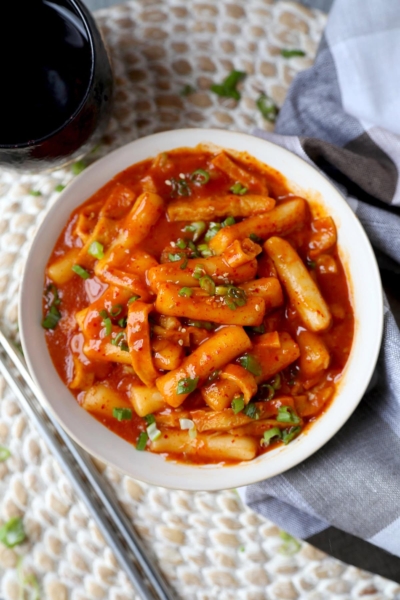















Questions and Reviews
I love this recipe. We add all the veggies we like and double the sauce. It’s soooo yummy. I like to add a little garlic chili sauce for some spice if I don’t have kimchi to eat with it.
The best of many I relised ❤️
This is my favorite Jap chae recipes. Thank you so much for sharing. It’s so healthy and it makes me happy every time I make it. So colorful!
Thank you so much, Maria! 🙂
This is such a beautiful looking dish. My question is what is difference between soy sauce and dark soy sauce?
Hi Janel! Dark soy sauce is thicker and slightly sweeter than regular soy sauce. But if you can’t find any, using only regular soy sauce also works 🙂
Love this easy recipe and for me it’s a win I watch my starch in foods I am a diabetic
That’s great Gillian! I hope you enjoy the recipe 🙂
Tried making this and love it! Would probably add some chili the next time I make it for a bit of “kick”.
We make a version of this with marinated stir fry beef; it’s still mostly veggies, though. We eat it once or twice a month and have yet to find houseguests who don’t love it. Hot, cold, and especially good with a little Sriracha on top!
I love this recipe and make it at least twice a month. I cut the sugar in half and use low sodium soy and it is still amazingly yummy. Meal prep done and keeps well for lunches!
Love japchae. Thanks for this incredibly easy recipe. So delicious and quick, I’d recommend it to any home cook!
What’s the sesame oil for?
Hi Cj, apologies for the misprint! The sesame oil is added to the noodles once they are drained. This keeps them from sticking together while the vegetables are frying.
How many servings of the ingredients do I use if I’m making it for a family?
Hi Amy, this recipe is for 4 people and as a main. You can easily double the recipe though if you are worried it may not be enough food. It keeps well in the fridge 🙂
Great recipe. Easy and quick. Thank a for sharing!
This recipe is great! We loved it. We made it a main course meal so we added cooked shrimp at the end. We will be making this again.
Wow, this Vegetarian Japchae recipe looks great!
Love the step by step photos + detailed instructions.
We shared it on our FB page.
Thank you!!! 🙂